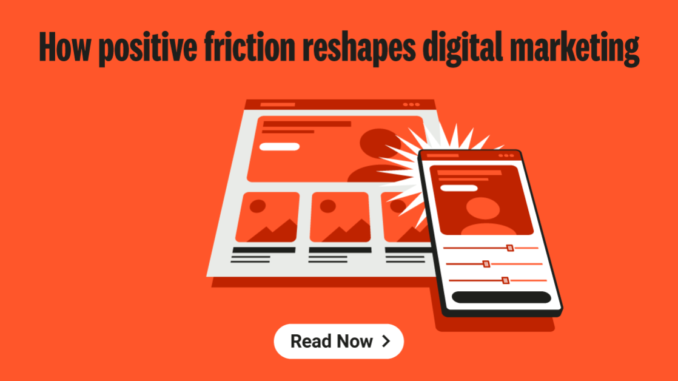
In today’s digital landscape, marketers are constantly striving to increase engagement and conversion rates online. To achieve this, their goal is typically to create seamless digital experiences for their customers. Friction is most often associated with pain points in the customer journey. However, eliminating friction altogether might be the wrong approach.
Why? Removing friction is often beneficial, but frictionless experiences are not memorable, nor do they encourage us to stop and think. Gartner’s 2022 Digital Customer Engagement Survey shows that while digital interactions are perceived as valuable by 73% of consumers, only 5% can actually recall a valuable digital interaction with a brand.
As Daniel Kahneman’s book “Thinking, Fast and Slow” teaches us, it is often wise to stop and think when making important decisions to avoid our automatic system making them for us. This is where friction comes into play: brands can use it to nudge customers to stop and think – and ultimately make the decision-making process conscious and memorable.
Unlike seamless digital experiences, catalytic interactions introduce positive friction, prompting consumers to pause and engage in self-reflection, for example, via an interactive self-assessment. An excellent example of this is L’Oreal’s Skin Genius, a “skin analysis tool powered by Artificial Intelligence technology that analyzes your skin’s specific needs and helps create a more personalized skincare routine”.
Instead of offering customers a selection of skincare products, it helps consumers analyze their own skin, educates them about their ideal skincare, and suggests products based on its findings. According to LaRocca-Cerrone, a catalytic experience has the power to change the customer’s purchase decision and decrease buyer’s remorse.
Catalytic interactions create a sense of agency and confidence in customers, making them more likely to feel good about their purchase decisions, and Gartner’s research shows that a single catalytic digital interaction can double the likelihood of commercially productive behaviors, such as increased purchases, repeat business, and positive advocacy.
But as a marketer, it is worth stopping and thinking about the right moment to introduce friction. According to Kristina LaRocca-Cerrone, the best moment to incorporate catalytic interactions is in decision-making situations that require more thought and reflection. When faced with ambiguous decisions or when emotions are involved, customers benefit from stop-and-reflect moments that prompt them to consider their goals and options.
By strategically placing catalytic interactions throughout the customer journey and combining them with personalized content and recommendations, businesses can create transformative experiences that resonate with their audience and drive marketing success.
Catalytic interactions can take place on various digital channels, including websites, web apps, search, and advertisements. Kristina LaRocca-Cerrone recommends that businesses guide customers toward catalytic experiences by strategically placing their ads based on consumers’ learning intent. Consumers with a high learning intent can be identified by the questions they ask, for example, “What running shoes should I buy?” instead of “What are the best running shoes?”
To achieve lasting customer engagement and tangible business value, embracing catalytic digital interactions is essential. These interactions introduce positive friction and encourage self-reflection, empowering customers to make informed decisions and boosting their confidence.
Strategically incorporating friction during moments of decision-making and combining them with personalized content can create transformative experiences. The Magnolia DXP offers the foundation and user-friendly tools to build interactive digital experiences, enabling businesses to drive customer engagement and business growth.
Sandra Schroeter Technical Product Marketing Manager at Magnolia
Sandra started her career managing mission critical environments at Hewlett Packard and found her way into product marketing via PostgreSQL consultancy. Having worked in the area of customer experience over the past few years, Sandra is passionate about creating customer-friendly digital experiences. In her role at Magnolia, Sandra is responsible for value-based product messaging for a technical audience as well as technical content strategy.

Leave a Reply